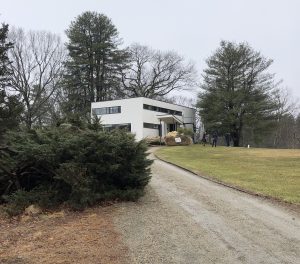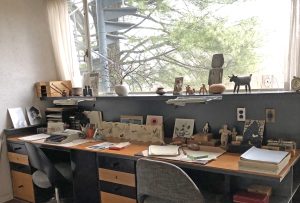On a rainy and gray morning in March of 2023 Jeffrey, Jan, and I embarked on a road trip to Lincoln, Massachusetts to see the Gropius House. Driving through the dense New England forest, the roads became winding and time slowed. Approaching the shining wet gravel driveway cut between bright green grass I didn’t see the house at first, but a compact modern black and white auto garage reinvented as a museum check point.
The house perched proudly like the unending line of stacked black stones along the roadside that we had seen on the drive. Jan Shepherd my aunt and former Arts Editor of the Boston Globe mentioned that the early New England pioneers hauled stones to the edge of the road while clearing their homesteads. This Gropius House may not have blended with its Colonial estate neighbors but the details within and without reminded me of the hard work and dedication of early pioneers.
The house perched proudly like the unending
line of stacked black stones along
the roadside that we had seen on the drive.
It seems the Walter and Ise Gropius never compromised. If they had to put in a switch plate, they were not going to settle for plastic that yellows with age; they opted for polished chrome. It is impressive that they worked together on every detail of the house. The spirit of coming up with building methods on the fly and sticking to an aesthetic that is different from the rest is bold and refreshing.
Imagine the neighbors walking their dogs viewing the black steel spiral staircase on the front black and white facade for the first glance. We spent most of the tour inside the house since it was steadily raining. I liked the office space that Walter and Ise shared. The working space had a harmonious quality to it with dark casework contrasted against lightness of the large window and delicate white drape. The collectibles gave the space visual curiosity. I don’t know much about the Bauhaus school but I can tell that the students must have been guided in many creative outlets. The do-it-yourself style is found here regarding the early 1920s Bauhaus Band,
In addition to kettledrums, side drums, cymbals and
cowbells, the percussion section included a
homemade pedal machine for the large side drum,
also with which an infernal din could be produced.
As Jani, Jeffrey, and I walked through Gropius House, I felt a harmony of building elements, textures, and color like a music score. The infernal din or diabolic sound that was homemade from the pedal machine in the early days of the Bauhaus Band could be heard in the Bauhaus Pink wall against a black and white striped pirate like screen on the upper deck. The black and white screen can be seen in the left corner of the photo below.
The Bauhaus Pink accent wall makes the green pines in the opening of the roof deck more vibrant and the tree makes the pale pink wall glow. This composition though private from the street view was and still is pretty diabolical for Lincoln, Massachusetts. Walter and Ise understood the power of complementary color and restraint.
We three had visited the Harvard Mineralogical & Geological Museum before the Gropius House in Lincoln. Looking back at the rock and mineral photos from the trip there is a display case that has a similar color palette to the photo above of the roof deck at Gropius House. The pink Dolomite Pseudomorph from Namibia is in harmony with the other green, black and brown Pseudomorphs. I think Walter Gropius would have definitely put this pink rock on his desk. Just think of the time when Le Corbusier was a house guest, the docent did state that Le Corbusier slept in the spare bedroom on the second floor! I know, it’s too much to take in.
Attribution
Jeannine Fiedler & Peter Feierabend, BAUHAUS (1999 Konemann Verlagsgesellschaft mbH), page 145.




